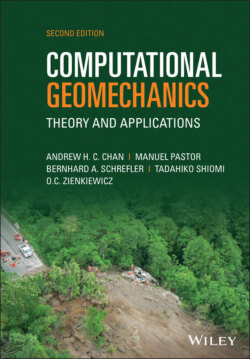Читать книгу Computational Geomechanics - Manuel Pastor - Страница 42
3.2.4 General Applicability of Transient Solution (Consolidation, Static Solution, Drained Uncoupled, and Undrained) 3.2.4.1 Time Step Length
ОглавлениеAs explained in the previous Section 3.2.3, the computation always proceeds in an incremental manner and in the u‐p form in general, the explicit time stepping is not used as its limitation is very serious. Invariably, the algorithm is applied here to the unconditionally stable, implicit form and the equation system given by the Jacobian of (3.46) with variables Δ and Δ needs to be solved at each time step.
With unconditional stability of the implicit scheme, the only limitation on the length of the time step is the accuracy achievable. Clearly, in the dynamic earthquake problem, short time steps will generally be used to follow the time characteristic of the input motion. In the examples that we shall give later, we shall frequently use simply the time interval Δt = 0.02 s which is the interval used usually in earthquake records.
However, once the input motion has ceased and its record no longer has to be followed, a much longer length of time step could be adopted. Indeed, after the passage of the earthquake, the remaining motion is caused by something resembling a consolidation process which has a slower response allowing longer time steps to be used.
The length of the time step based on accuracy considerations was first discussed in Zienkiewicz et al. (1984), Zienkiewicz and Shiomi (1984), and, later, by Zienkiewicz and Xie (1991), and Bergan and Mollener (1985).
The simplest process is that which considers the expansion for such a variable as u given by (3.43) and its comparison with a Taylor series expansion.
Clearly, for a scalar variable u, the error term is given by the first omitted terms of the Taylor expansion, i.e., in scalar values
(3.48)
Using an approximation of this third derivative shown below
(3.49)
we have
(3.50)
For a vector variable u, we must consider its L2 norm, i.e.
(3.51)
and we can limit the error to
(3.52)
This limit was reestablished later by Zienkiewicz and Xie (1991) who replaced the leading coefficient of (3.52) as a result of a more detailed analysis by
(3.53)
Whatever the form of error estimator adopted, the essence of the procedure is identical and this is given by establishing a priori some limits or tolerance which must not be exceeded, and modifying the time steps accordingly.
In the above, we have considered only the error in one of the variables, i.e. u but, in general, this suffices for quite a reasonable error control.
The tolerance is conveniently chosen as some percentage η of the maximum value of norm ‖u‖2 recorded. Thus, we write
(3.54)
with some minimum specified.
The time step can always be adjusted during the process of computation noting, however, not to change the length of the time step by more than a factor of 2 or ½, otherwise unacceptable oscillations may arise.
